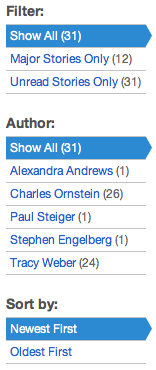
Late last night, ProPublica launched a redesign of its website. As most site revamps tend to be, the new propublica.org is sleeker, slicker, and generally more aesthetically pleasing than its previous incarnation. But it’s also more intuitively navigable than the previous version, incorporating the accumulated wisdom that the investigative outfit has learned about its users, its contributors, and its journalism in the past two-and-a-half years. As Scott Klein, the outlet’s editor of News Applications and the site revamp’s chief architect, puts it in his intro to the redesign:
When we first sat down to design our website in early 2008, we had just started as an organization, and we had yet to publish anything. We had only a skeleton staff. We had to create something of a Potemkin village website, guessing at the kinds of coverage we’d be doing and how we’d be presenting it. In the two years since, we’ve constantly tweaked the site, and have bolted on new features that we never imagined we’d be doing.
With this redesign, we’ve tried to take everything we’ve learned, and everything we’ve added, and put it together into one nice, clean site. Our hope is that the level of design sophistication now matches the sophistication of our reporting.
The revamp has been in the works, in earnest, basically since November, Klein told me — with many of the intervening months spent not in designing and coding, but in conversing: explaining to the designers the outlet hired to help with the overhaul (the San Francisco-based firm Mule) what ProPublica does and what it’s about. Before they could design ProPublica’s new website, Mule essentially “needed to get a Masters degree,” Klein says, in the organization itself.
It seems they did. Propublica.org now feels more mission-coherent than the original site. The “Donate” button is more prominent than on the previous version — a not-so-subtle reminder that ProPublica, known as it is for the substantial funding it’s received from the Sandler Foundation, is always looking for more money, from more sources, to sustain its work. (Speaking of, scratch that: It’s “Donate” buttons that are prominent, three on the front page.)
The site has also added, in its “About Us” section, a list of FAQs — complete with (helpfully, delightfully) an audio-filed name-pronunciation guide: “Some pronounce it Pro-PUB-lica, some Pro-POOB-lica. Most folks here in the newsroom pronounce it Pro-PUB-lica. Of course we’re always happy to be mentioned, using any pronunciation.” (The ProPublica staff were inspired to write FAQs, senior editor Eric Umansky told me, by fellow-online-only-nonprofit Voice of San Diego — which posted its own FAQs last week.)
The new site tries to answer questions in the broader sense, too. In a recent episode of their “Rebooting the News” podcast, Jay Rosen and Dave Winer discussed the systemic challenges of the multi-level crowd: audiences — or users, or readers, or whatever term you prefer — who come into stories with differing amounts of prior knowledge, differing contextual appreciations, differing levels, essentially, of interest and information. One problem news organizations face — and it’s a design issue as much as a strictly editorial one — is how to engage and serve those different users through the same interface: the website.

 The ProPublica redesign tries to address that issue by making consumption of the journalism its site contains a choose-your-own-adventure-type proposition. The revamped site, like its previous version, features, at the top of every page, a list of topics that have become focus areas of ProPublica investigations (currently, “Gulf Spill,” “New Orleans Cops,” “Loan Mods,” and six more). Now, though, the landing pages of those topic-based verticals (whose content is generally organized chronologically, river-of-news-style) also feature curated, interactive boxes that incorporate live data from ProPublica’s news applications. Check out the “Calif. Nurses” vertical, above — anchored by “Problem Nurses Remain on Job as Patients Suffer,” a finalist for this year’s Public Service Pulitzer. Scroll down past that top curated box, and there are further options for self-navigation: Users can filter stories according to their general significance (the “Major Stories Only” button), their personal significance (the “Unread Stories Only” button), their author, or their age.
The ProPublica redesign tries to address that issue by making consumption of the journalism its site contains a choose-your-own-adventure-type proposition. The revamped site, like its previous version, features, at the top of every page, a list of topics that have become focus areas of ProPublica investigations (currently, “Gulf Spill,” “New Orleans Cops,” “Loan Mods,” and six more). Now, though, the landing pages of those topic-based verticals (whose content is generally organized chronologically, river-of-news-style) also feature curated, interactive boxes that incorporate live data from ProPublica’s news applications. Check out the “Calif. Nurses” vertical, above — anchored by “Problem Nurses Remain on Job as Patients Suffer,” a finalist for this year’s Public Service Pulitzer. Scroll down past that top curated box, and there are further options for self-navigation: Users can filter stories according to their general significance (the “Major Stories Only” button), their personal significance (the “Unread Stories Only” button), their author, or their age.
The idea was to give users several paths into, and among, stories and topics, Klein explains. It’s a kind of one-size-fits-all approach…via, yes, a recognition of the inadequacy of one-size-fits-all. Google’s Living Stories experiment was an inspiration in that respect, Klein says, as was the filter-focused layout of the website of Washington’s Spokesman-Review. The changes are about making the site a personal, and even somewhat personalized, place — and about making it accessible to new users while still compelling for the old.